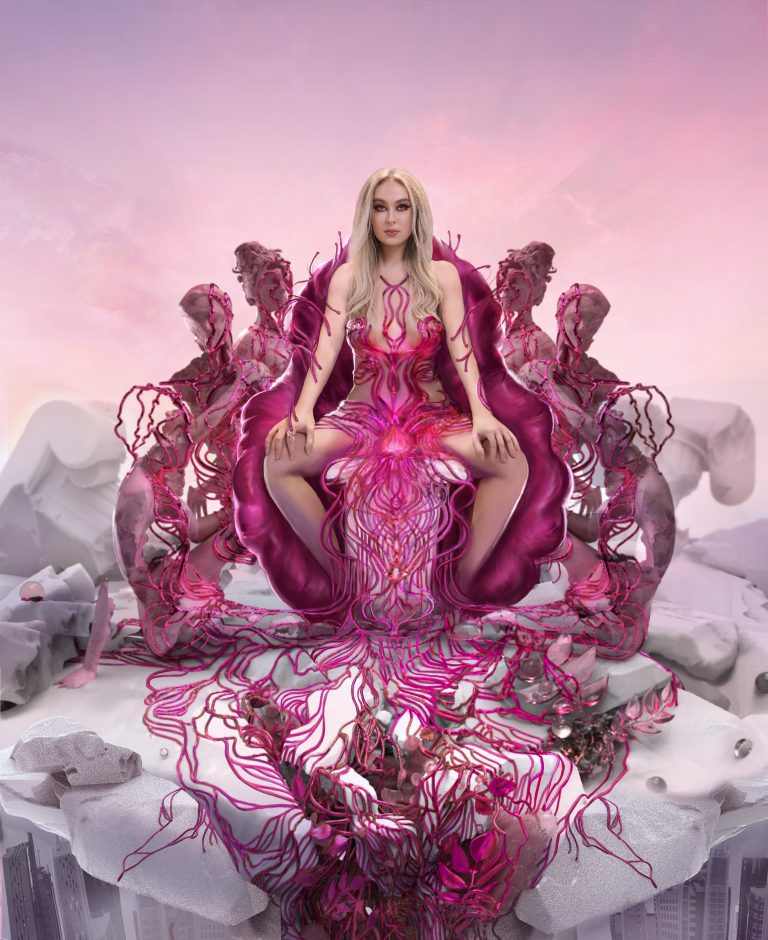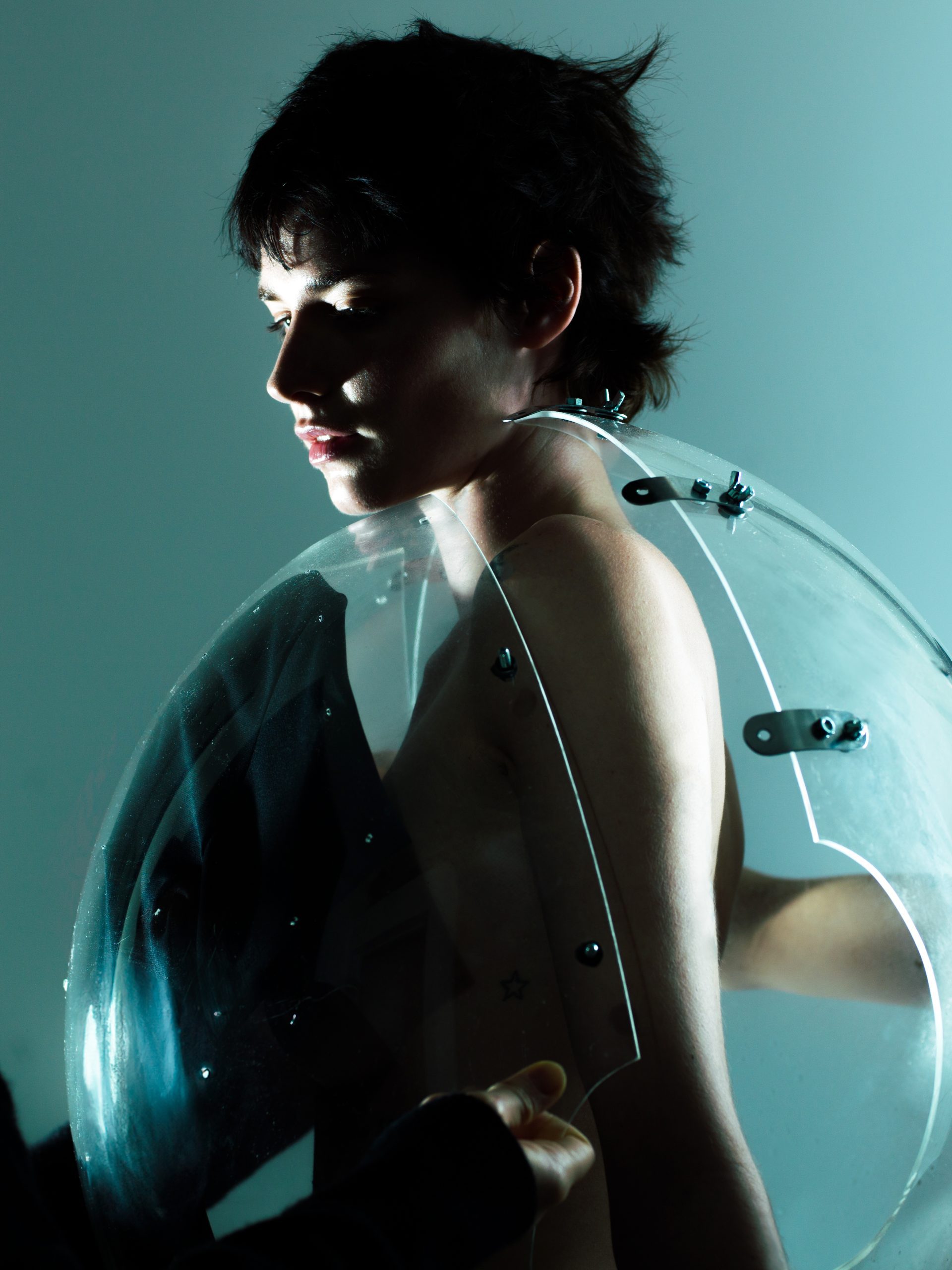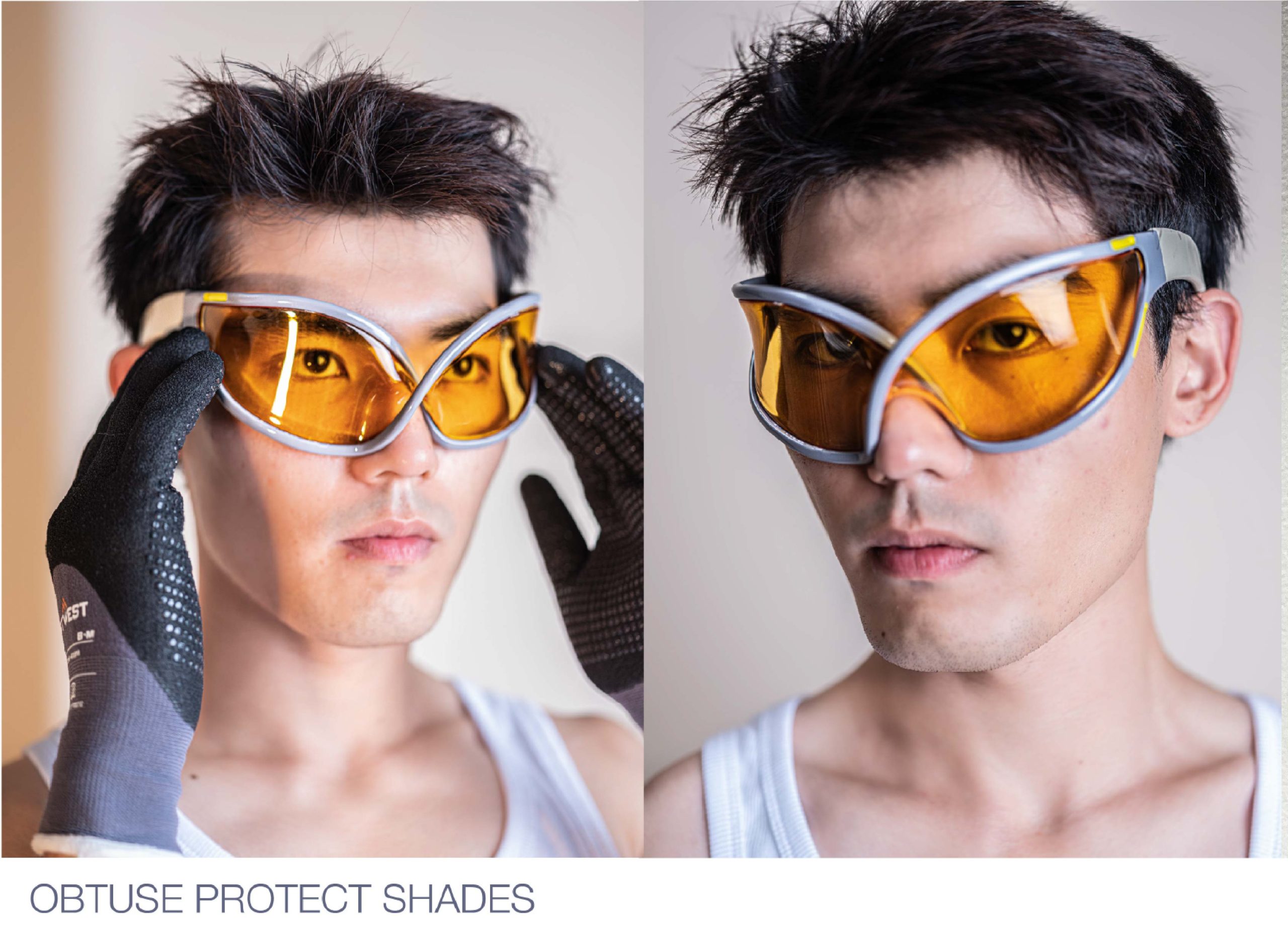Katie McIntyre, a visionary designer and artist, delves into the deep visual and historical research that underpins her groundbreaking work, exploring the experience of womanhood and its cultural representation. Her art challenges patriarchal norms, celebrates the power and divinity of the female form, and aims to reshape the narrative around women’s roles and representation in various fields. From her bold album covers to her zero gravity space suit designs, she pushes the boundaries of innovation while honouring feminist art principles, all while advocating for gender equality and social change.
Your work incorporates deep visual and historical research into the experience of womanhood. Can you share an example of how this research has influenced your art and design philosophy?
The experience of womanhood is often connected with the expression of it in culture. Through my research I discovered how much of the world is designed in fear of the female body, the patriarchy has a desire to suppress the power and expression of it. The result has been my direct effort to counter-act this multi-century-long effect by creating works that celebrate the divinity and power of the female form, including taboo elements of it like menstruation, lactation, and birth. I have created album covers that dive into the ancient history of female-led empires and goddesses that were previously revered. In doing so, I have reintroduced a previously discarded perspective on women’s place in the world. The Queen cover for Nicki Minaj and the Wild Side Cover for Cardi B and Normani were based off of this research. Typography is part of the design that has a patriarchal origin that is based on the study of the divine proportion which came from the male body. Most people are unaware that we have been limited to the male form of expression within typography. This is why I add subliminal references and shapes to my typography and branding that come from the woman form.
You’ve mentioned you’re an “anti-hero” and pushing back against damaging narratives of the patriarchy. How do you translate this defiance into your artwork and design?
It’s not an easy road to challenge visual standards that have been accepted and implemented for a long period of time. I have faced vilification for my beliefs, which is why I adopted the title of the anti-hero. To a portion of the population, I am the hero, but some consider me a villain, therefore I am the anti-hero. A few of my projects that are clear.
Examples of this are my project “Zenith Women” in Dubai, my album cover “Pussy” for Latto and my car design Dakini. All of these works explore a yonic, empowered perspective of the female body in a realm that has not previously seen it. Zenith Women at Art in Space Dubai was the first piece of its kind to celebrate the divinity of the female form in the Gulf. The cultural element and the desire to challenge patriarchal norms in this region were important to me because I recognize as a woman in the West, I have certain privileges and I want to advocate for the voiceless and also allow people to see the world differently through my art. The piece was very provocative and definitely had a large emotional response, both an excitement towards the work and also in some cases an anger towards it. The Pussy album cover created for Latto depicts a mechanical woman’s body with her legs spread in front of the Supreme Court. It was released after the overturning of Roe v Wade. It was a direct combat towards the efforts towards the control of women’s bodies. The car design Dakini approaches an incredibly patriarchal and rigid industry and reimagines it completely. In order to create a work like this you have to come from a defiant perspective, you have to look at the entire industry and reject the system completely. The core design of the car is influenced by the architecture of Zaha Hadid and the material design of Neri Oxman, it builds off of the work of great women innovators and provides another perspective on where the future can go.
You’ve created a universal design ethos that investigates the experience of womanhood. How do you ensure that this ethos is inclusive and accessible to people of all genders?
I think this is a fascinating question, and I’ll explain why.
When we go out in the world, most things are influenced by an unconscious bias towards phallicism and the male body. Judy Chicago, the feminist artist, in her collaboration with Dior, wrote the question, “If women ruled the world would all buildings resemble wombs?”. This was for a reason, we have a phallic world, but it is deemed universal, human, the question is never posed if it’s inclusive because it’s the framework for our world. I believe womanhood is universal, the female form is just as human and universal as the male form. I think the position that womanhood only belongs in a certain section, off to the sidelines, because it’s non-inclusive, is incorrect. This is sort of the same belief system where people believe that you can’t listen to music created by women if you are not a woman or appreciate women films or books if you are not a woman. It’s just not true.
When we look back in time, some of the oldest artworks and buildings contained Venus sculptures, there used to be a time when the humanity of womanhood was accepted. We have gone backwards. In my work, I make a deliberate effort to collaborate with women across all body types and ethnicities, men, and non-binary individuals who understand the universal aspect of feminine expression.
Your Zero Gravity Space Suits aim to address the lack of suits designed for women in space exploration. Could you discuss the significance of custom-fit space suits and their impact on gender equality in the field of astronautics?
Over the past few years, I have been doing research into developing zero gravity suits designed to encourage a new aesthetic and design principle as it relates to women in space. The space suit was modeled by Bionic Pop artist and Space Advocate Viktoria Modesta and was exhibited at the historic Yuri’s night at the Los Angeles Science Center. Part of the space suit’s design is similar to that of a “vulva rocket” that sits front-and-centre on the front pocket of the suit, which is designed to house menstruation products. I am trying to rewrite history where women were not allowed to become astronauts because of menstruation, and NASA was unable to accommodate that.
The research process included researching tech fabrics and materials that would relate to a higher degree of external communication in space. Having, for instance, a color change on your suit to indicate panic would be a necessary element in space. Communication using tech fabrics was a significant aspect of the research.
Additionally, creating a space suit design that is an extension of the space ecosystem was a natural part of this design. The design is influenced by cosmic webs, it expands and contracts in zero gravity based on the movement of the user. The structure of our universe is like a sponge made up of clusters of galaxies intricately connected by filaments of galaxies—a magnificent structure now called the “cosmic web” and mapped extensively by teams of astronomers. The space suit design is a reflection of this connection.
Space suit design, both as an art form, as an expression and motivation towards greater equality, has been largely ignored. Representation and design towards women’s bodies have been an obstacle to the continued growth of women in the field. My work in this area has been highly considered with an understanding that breaking barriers in astronautics happens when there is a deeper understanding of how to inspire the global audience of women to be involved.
Your art series on Shameless Menstruation and Lactation Couture aims to challenge the shame and stigma surrounding women’s bodies. How do you portray these natural processes as bold, powerful, and beautiful in your artwork?
The formal design of this couture plays into the beauty of it. The dripping of the milk down the breasts and the design references menstruation were done over several months and with fine detail. There were deliberate material studies in order to capture the experiences of these aspects of womanhood from a beautiful lens. The bottoms are created from layers of chiffon and metallic silks and appliqués. The attention to detail and focus on capturing an expressionistic viewpoint played into the overall impact of beauty.
Can you share a specific experience or instance where your voice has been suppressed or ignored within the technology industry, and how you overcame these challenges?
I have worked for some of the biggest technology companies on earth. I had some scarring experiences early on that really impacted me. I was sexually harassed, degraded and bullied in my environments. I was made to feel that female power was something to hide and be ashamed of. I was even told directly that female empowerment was not a brand value at one of the biggest companies on earth. This definitely impacted me, Surprisingly, women in leadership roles did everything possible to silence me. They were used as the first line of defense in the patriarchy which felt like a deep betrayal. I was also sexually harassed and when I reported it I was threatened, and told if I told anyone inside or outside the company I would immediately be fired. It was a traumatizing experience that took many years to recover from and created a lot of motivation for me to become a change agent in the field. It was a challenge to overcome these feelings of fear, of the massive power difference between my voice and the industry’s voice that was silencing mine. Part of what also empowered me was having other conversations with women in the same tech company who were gaslighted in the exact same way, even with the exact same phrases used against them. The systematic element of it, although incredibly disturbing, felt less personal and helped me to overcome it. I have healed a lot by creating the kind of work that was not welcomed or accepted in these environments in the front and center of the public eye, with A-list artist collaborations.
Your work combines historical and feminist art principles with emerging design philosophies. How do you navigate the balance between honoring the past and pushing the boundaries of innovation in your artistic process?
The work of artists and designers like Judy Chicago, Hilma Af Klimt, Georgia O’keefe, Iris Van Herpen, Zaha Hadid, Neri Oxman, is invaluable. The painters in this set of names provide a formal visual study of the world and womanhood through shapes, strokes, expressions, ideas and visualizations. I treat all my inspirations as books of inspiration and a foundation to build on. Apple based a lot of its design philosophy on an art movement in Germany called the Bauhaus. I have had a similar approach in taking inspiration from feminist artists and building off of their perspective with emerging technology, new tools and my own personal voice. The album cover I created for Latto was influenced by Judy Chicago’s birthing paintings but taken into 3-D software with more of a political stance and my personal expression. Iris, Zaha and Neri have such rich and in-depth understandings of innovation, form, materials, and design. All of this work is highly influential in my understanding of where the future can go and how a woman-centric vision can be built through my work.
In what ways do you believe feminine futurism can reshape the narrative around women’s roles and representation in technology, pop culture, and society as a whole?
The Feminine Future looks a lot like Earth except there are real-life superheroes. These are not the superheroes you earthlings are used to. They have no spider webs or bat caves or flying capes. They aren’t titans of industry or conquerors of land or captains of capitalism. They aren’t girl bosses or badasses or freedom fighters or heavy hitters or trailblazers or content creators or go-getters or wheelers and dealers or movers and shakers. They do not subscribe to grind culture. They are still. They are slow. They are calm. They exist in the feminine future; a post-patriarchal state of serenity. They bathe. They dream. They breathe. They are attracting not chasing. They are larger than life. Free from the fight. Givers of light. The world around these goddesses is created in their own image, feminine curves take up the forms of this world, a culture that now embraces female empowerment rather than suppresses it.
The world is designed by us, and it’s in trouble. Women are battling for their rights globally and the earth, Mother Earth, has been so disrespected that our species is under threat. Patriarchy has been deadly for our society. We all need to embody a feminine, nurturing aspect of our humanity in order to survive and surpass this period. These issues are fast approaching and very real. There is also a misnomer that femininity means weakness, but those who understand the laws of nature understand the mother animal is the most deadly and powerful creature in the animal kingdom. When as a culture, we embody the perspective of mothering our planet, of raising the consciousness for a higher level of respect towards women and our earth, I think we have a fighting chance. I plan on launching my own brand this year that has product offerings that match this value system and perspective. I think pushing our culture towards a woman-centric vision will change the dynamic of how women are understood consciously and subconsciously. Design, representation, and innovation have extreme power, creating empowered designs that are created to co-exist rather than control nature is necessary. There are statistics that show in the places in the world where the earth is distracted the most women are also disrespected the most. I think this disrespect has always been connected and as a culture, we need to reconnect it, in a really bold, formal way.
Your art has been recognized and supported by prestigious publications and brands. How do you see your role as an artist in influencing and shaping the cultural conversation around feminism, gender equality, and social change?
I think my role is personal and universal. I sometimes do not even consider myself an artist because, in the end of my journey, I really want to create products for people, even If they are viewed as works of art. I want to evoke emotion, inspire change and provide inspiration. I think sometimes my role is trail-blazing, which requires a lot of fire and grit to survive. There have been many obstacles in my path and even some of my collaborations I had to really fight for, they did not come easily. I hope my impact will be that there will be less of a fight ahead because of me and that a young girl can look up my work in a textbook and not feel like she is starting from scratch, that there is a depth of work left behind to build on and take inspiration from.
Words by Katie McIntyre
Interviewed by Fernanda Ondarza from GLTICH Magainze





